2012 Annual Science Report
 University of Wisconsin
Reporting | SEP 2011 – AUG 2012
University of Wisconsin
Reporting | SEP 2011 – AUG 2012
Project 4C: New Ways for Exploring Mars for Environmental History and Biosignatures
Project Summary
In situ analyses on Mars may take many different forms. We have focused on developing an instrument mounted on a Rover that can make wet chemical analysis of Martian soils. Samples are taken by the Rover’s arm into a scoop which delivers them to a hopper. They are fed from there to one of a number of “test tubes” containing water where they are mixed to extract chemicals for analysis. The analytical process uses a probe, with a number of analysis electrodes attached to it, which dips into the tube. We tested the instrument on a Rover in the JPL Mars Yard, the in-house test field, and were able to demonstrate a successful, complete operational sequence using synthetic soil as the test material.
Project Progress
The WCL (Wet Chemistry Laboratory), part of the 2007 Phoenix mission to Mars, had the ability to mix soil samples with water and analyze the chemical composition of the resulting solutions with a range of electrodes. A next generation instrument, RCAL (Robotic Chemical Analysis Laboratory) was built by the Starsys company and later developed further by colleagues at Tufts University (shown in Figure 1).
Left Panel: The original RCAL.
Middle Panel, A: top left shows the top of the unit with soil delivery mechanism (inverted). Below is the Sensor Insertion component
Right Panel, B: the Dip probe stations in detail.The system can be configured with a different probes, for chemical analysis, to measure temperature, redox state, pH; or just a stirrer to mix the soil and water.
In our work at JPL we modified the original design to minimize the likelihood of errors in operation and to reduced its mass considerably by replacing the metal parts with those made from plastic or a composite material. We then integrated it, mounted on the SRR2K, a technology prototype of the small rover, intended for development for the 2001 Mars sample return mission (Figure 2). The mission was later canceled, but the rover was used subsequently to train the MER science team for mission operations.

The SRR (Sample Return Rover) showing theModified RCAL wet chemistry lab, with the grey composite top cover and translucent main body. It is mounted on the rover deck and shows the delivery of a sample to RCAL by the sample acquisition scoop mounted on the SRR arm.
In the last year we have completed the developments, installed new miniature electrodes developed at Tufts University. We first tested the complete system in the laboratory and after making minor modifications took it to the JPL Mars Yard, which is usually used as the first outside testing ground for all the JPL rovers We prepared some synthetic soil consisting predominantly of pure silica sand to which a number range of chemicals to be analyzed was added before the whole sample was mixed thoroughly to make sure it was homogeneous. We placed some of the synthetic soil on a cleaned slab of rock and ran a complete operational sequence in which the Rover’s arm and scoop took a sample, delivered it to the RCAL, which then performed duplicate analyses (Figure 3).
This documents part of the technical demonstration in the Mars yard. The scoop on the rover arm sampling was sampling synthetic soil, which was then delivered to the sample hopper, as shown in Figure 2.
The experiment was a total success and we are now able to make further improvements in the range of chemicals to be analyzed and the few subtle modifications to the operational sequence. This work should eventually after further development offer opportunities for in situ astrobiological investigations of chemical or mineral biosignatures.
-
PROJECT INVESTIGATORS:
-
PROJECT MEMBERS:
Hrand Aghazarian
Co-Investigator
Michael Garrett
Co-Investigator
Terrance Huntsberger
Co-Investigator
Isik Kanik
Co-Investigator
Samuel Kounaves
Co-Investigator
Kyle McElhoney
Graduate Student
-
RELATED OBJECTIVES:
Objective 7.1
Biosignatures to be sought in Solar System materials


